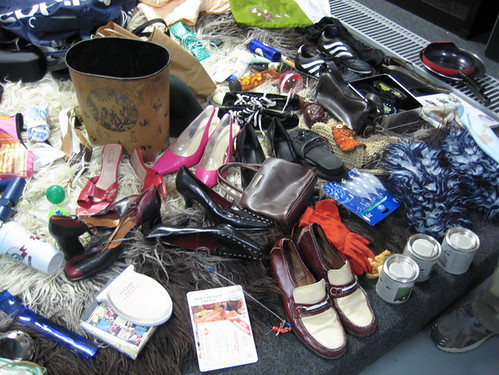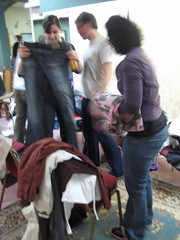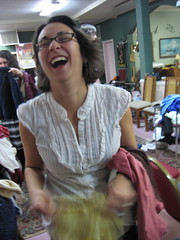For those of you who may not already know, it’s earth hour this coming Saturday night.... Well, that is, in Australia. If you’re in the States or the UK or any other marvellous part of the world for that matter, then it’s 8pm on the 29th of March, your local time.
All you have to do is sign up on the web site and when earth hour rolls around, turn everything electrical off in your house. Lights, tv’s, dvd’s, ipods, kitchen white goods and yes even your beloved computer.
You could then light a candle or two or, as many are doing, gather with others and watch you local city lights switch off. I think it's going to be amazing.
This little clip may help explain where it all began (Sydney, Australia 2007). It may make you want to join in too. I hope so.
March 28, 2008
March 18, 2008
A grey water solution for someone with no plumbing skills

For a few years now I’ve not had a washing machine. It’s called for the occasional trip to my folk’s house to use their machine, and to the dry-cleaners for silks and delicates. But on the whole it’s called for a great deal of hand-washing. Lots and lots of hand-washing in a small bucket or the bottom of the bath. It’s been a little slow and laborious at times, but on the whole not too bad, save for jeans and woolly jumpers. And all those buckets of grey water were easy to cart out and pour onto the garden.
However, as soon as the option of installing both a water and energy efficient machine became possible, I welcomed it with open arms. Yay! I cried, no more 18th century washerwoman for me.
Even though my new machine is super efficient it still uses a fair bit of water. The green solution was easy, even easier than carrying bucket loads of water out to the dry, struggling garden beds. It is a grey water solution perfect for someone with no plumbing skills. Perfect for me, and perfect for you, too, I suspect.
It goes a little like this…
Walk down to local hardware shop and purchase a grey water diverter hose, 10 metres in length (minimum).

Connect the grey water diverter hose to the washing machine's drainage hose (of the same diameter). The diverter hose has a flexible plastic end to it which stretches tightly over the end of the washing machine's hose so that it doesn’t leak or separate once the machine starts a-swirling. If you’re feeling extra handy, screw on a clasp to this join to make it extra strong.

Unravel the full length of the grey water diverter hose, extending it from the washing machine, over the laundry floor, out the back door and onto the garden.
Turn Machine on and watch the grey water drain out onto the garden… you can almost catch sight of the trees and plants smiling quietly with relief.

If you have a flat garden, as I do, then you wont have the benefit of gravity to help you drain the pipe completely once the washing cycle is finished. In this case, simply disconnect the grey water diverter hose from the washing machine's drainage hose and hold this end of the grey water diverter hose up high. This will drain out what water remains in the hose.
I think the only trick is to be aware of the basic dos and don’ts of grey water usage, and more importantly what washing powder or liquid you use as this will be going onto your garden. I’ve been using this one and it seems great thus far, but there are many more eco friendly ones on the market.
There’s so much information about grey water recycling and systems, just look to your favourite green info source and I’m sure you’ll find all the details you need.
(Originally published elsewhere.)
Labels:
around the house,
laundry,
recycled,
water conservation,
what can i do
March 17, 2008
swap style
Ever since college, a group of our friends has been getting together a few times a year for a clothes swap. I love the clothes swap, particularly now that I'm not buying anything new (thank you, Wardrobe Refashion!). This time I came home with a great haul: several tops to wear to work, a great skirt, some short pants for spring, an orange vintage crocheted blouse, and some great socks for making sock monsters. And nothing beats the price: free!
If you've never been to a clothes swap and you'd like to try cooking one up with some friends, here's what you'll need to do it:

Space. We've always had the clothes swap at someone's house, though lately it's gotten quite large and we had to move it to a bigger venue (in this case the performance space at a wonderful music shop in downtown Raleigh). As long as you've got a main area for laying out clothes, and two spaces for dressing rooms (one for fellas, one for ladies), you'll be all set.

Clothes. The price of admission is at least one clean garment in good condition. I usually have a shopping bag or two; some folks come with just one item and some come with huge bags full. At a clothing swap last fall, I scored a beautiful black crepe suit made for a friend's great-aunt in Paris in the 1950's.


A cooperative spirit. This is not a competition, it's a free fashion night. The most successful swappers hunt in teams. If you dig up the perfect skirt for your friend, toss it to her. She'll do the same for you.

cats and catnip are optional at most clothes swaps
Basic rules. This is the least fun part, so I prefer to minimize rules, but suit yourself. The way we do it is, start at 7PM. Lay out the clothes by type (pants, skirts, jackets together, etc). We never used to segregate clothing by gender, but as this thing has grown quite huge, it's starting to seem like a good idea. Don't start swapping until it's time... time is around 7:30. Keep swapping until your appointed time, say 9 PM. No limits on how much you can take - just as long as you actually plan to use/wear it. Then everyone helps bag up what's leftover to take to the thrift shop.
Snacks. Not required, but highly recommended. We do it potluck-style, and the fare ususally consists of chips, salsa and some beers. The quantity of beer usually correlates directly to the zaniness of outfits that people start modeling as the evening goes on.


Clothes swapping is a lot of fun and very economical. It's also a delight to see your old favorite clothes getting a second (or third, or fourth) time around on your favorite people.
If you've never been to a clothes swap and you'd like to try cooking one up with some friends, here's what you'll need to do it:

Space. We've always had the clothes swap at someone's house, though lately it's gotten quite large and we had to move it to a bigger venue (in this case the performance space at a wonderful music shop in downtown Raleigh). As long as you've got a main area for laying out clothes, and two spaces for dressing rooms (one for fellas, one for ladies), you'll be all set.

Clothes. The price of admission is at least one clean garment in good condition. I usually have a shopping bag or two; some folks come with just one item and some come with huge bags full. At a clothing swap last fall, I scored a beautiful black crepe suit made for a friend's great-aunt in Paris in the 1950's.


A cooperative spirit. This is not a competition, it's a free fashion night. The most successful swappers hunt in teams. If you dig up the perfect skirt for your friend, toss it to her. She'll do the same for you.

cats and catnip are optional at most clothes swaps
Basic rules. This is the least fun part, so I prefer to minimize rules, but suit yourself. The way we do it is, start at 7PM. Lay out the clothes by type (pants, skirts, jackets together, etc). We never used to segregate clothing by gender, but as this thing has grown quite huge, it's starting to seem like a good idea. Don't start swapping until it's time... time is around 7:30. Keep swapping until your appointed time, say 9 PM. No limits on how much you can take - just as long as you actually plan to use/wear it. Then everyone helps bag up what's leftover to take to the thrift shop.
Snacks. Not required, but highly recommended. We do it potluck-style, and the fare ususally consists of chips, salsa and some beers. The quantity of beer usually correlates directly to the zaniness of outfits that people start modeling as the evening goes on.


Clothes swapping is a lot of fun and very economical. It's also a delight to see your old favorite clothes getting a second (or third, or fourth) time around on your favorite people.
March 11, 2008
poppy talk green market

buy local, buy handmade, re-use, re-cycle. sure we all want to do what we can. but what do you do when you just do really want to BUY something. you know - that consumerist itch we're all trying not to scratch?
well - at least this month you can put a little bit of money where your mouth is and support up and coming creative folks.
jan - the genius behind poppytalk has put together an eco themed market for us this month. up through april 11th.
shop with a little less guilt here
March 2, 2008
Cloth Pads + Goods 4 Girls

I got this email from Deanna and thought it might be of interest to our readers:
I don't want to take up much of your time, but I did want to tell you about a new project I just started, Goods 4 Girls. In short, it is an organization that collects donations of new, reusable menstrual pads (aka Mama pads) from women who either want to sew their own or want to buy pre-made ones. Goods 4 Girls is working with aid organizations in Uganda and Kenya to distribute the pads to girls in need.
There are currently Tampax and Always ads airing on television regarding Proctor and Gamble's donations of disposable pads to South African schoolgirls to help keep them in school. My concern when I first saw the ads was with the environmental impact of the disposable menstrual products. So, I posted on my blog about the alternative with reusable pads and the interest was great enough that I started up Goods 4 Girls and now have several aid organizations on board. To sum it all up, girls miss school when they have their periods because they don't have adequate supplies.
Currently, GladRags is offering a promotional Goods4Girls kit to be donated to Goods 4 Girls and other large pad manufacturers will be do so soon. The interest is very high with this project.
In the future, part of the program will involve assisting local African communities in teaching women and girls how to sew their own pads with materials donated and sent via Goods 4 Girls so they can be more self-sustainable.
You can find out more information about the project at the website . If you are interested in promoting the project on your blog, there are different buttons you can grab from the contact page
nikki posted awhile back on sew green about making her own cloth pads . the tutorial is on the right.
and if you are interested in purchasing some really cute and well made handmade pads you can visit amanda's shop modern acorn on etsy.
Labels:
activism,
by lisa s,
good cause,
handmade,
links,
what can i do
Subscribe to:
Posts (Atom)
